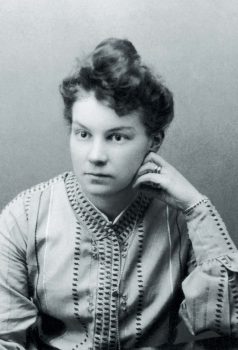Search results for "2011/04/2010/05/song-without-words"
Onward, downward!
31 March 1994 | Archives online, Fiction, Prose
Lauri Viita (1916–1965) was one of the self-taught writers who made his debut after the Second World War. His extensive, realist novel Moreeni (‘Moraine’, 1950) taking place in Viita’s native Tampere, begins with this prose poem
…over wolds, hummocks, ridges, between boulders, under branches, from cabin to cottage to manor, from coppice to fen, and ditch to puddle – down it drew us, the sloping earthcrust, southward the magnificent granite ploughland slanted.
Paths linked to paths, brooks joined brooks. Onward, downward! The roads widened, the currents strengthened. Bigger and bigger, heavier and heavier were the loads they could sustain. More and more trees, bread, potatoes, butter, meat, people and gravestones, huge boulders, rocks, went into the maw of those channels, and the hunger only redoubled. From channel to strait, from hour to hour, the lines of barges crawled along; from day to day the broad rafts of logs passed their sleepless summer on the long blue strip of Lake Näsijärvi. Spruce, pine, birch, aspen – different pieces for different purposes. How vast the supply and how vast the need! The months and days went by; in the depths of the lake, layer after layer, there wandered the shades of clouds, ships, faces. More…
So close to me
19 August 2010 | Reviews
Please try this first, before we enter the chamber of horrors. It’s a poem by Timo Harju:
… The old people’s home is the strange hand of God with which he strokes
his thinning hair,
a sudden shower of cackling in the dry linen closet, slightly
sad and lonely
God looks out, stirring his cup of tea as if it were on fire.
If Jesus had lived to grow old and gone into an old people’s home,
he would have been like these.
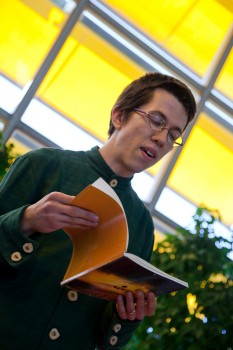
Timo Harju was awarded the 2009 Kritiikin kannukset prize (‘the spurs of criticism’, 2009) of the Finnish Critics' Association, SARV. Photo: Pia Pettersson
This spring a young Finnish female nurse was sentenced to life imprisonment for using insulin to murder a 79-year-old mentally retarded patient. Not long after, sentence was passed on another nurse – this time a meek and submissive-looking middle-aged woman who had murdered a whole series of elderly patients with overdoses of medication.
These are the terms – those of ordinary crime journalism – in which our recent public discussion of long-stay care of the elderly here in Finland was conducted. The discussion was followed by the usual misery of cuts, unchanged diapers, dehydration, over-medication, poor wages for hard work… No wonder that the concept of ‘healthcare wills’ and ‘living wills’, in which people are supposed to say how they want to be cared for in the last stage of their lives – is acquiring a disturbing undertone of ‘better jump before you’re pushed.’ More…
Star-Eye
31 March 1984 | Archives online, Children's books, Fiction
A story from Läsning för barn (‘Reading for children’,1884). Introduction by George C. Schoolfield
There was once a little child lying in a snowdrift. Why? Because it had been lost.
It was Christmas Eve. The old Lapp was driving his sledge through the desolate mountains, and the old Lapp woman was following him. The snow sparkled, the Northern Lights were dancing, and the stars were shining brightly in the sky. The old Lapp thought this was a splendid journey and turned round to look for his wife who was alone in her little Lapp sledge, for the reindeer could not pull more than one person at a time. The woman was holding her little child in her arms. It was wrapped in a thick, soft reindeer skin, but it was difficult for the woman to drive a sledge properly with a child in her arms.
When they had reached the top of the mountain and were just starting off downhill, they came across a pack of wolves. It was a big pack, about forty or fifty of them, such as you often see in winter in Lapland when they are on the look-out for a reindeer. Now these wolves had not managed to catch any reindeer; they were howling with hunger and straight away began to pursue the old Lapp and his wife. More…
Bear necessities
10 January 2013 | This 'n' that
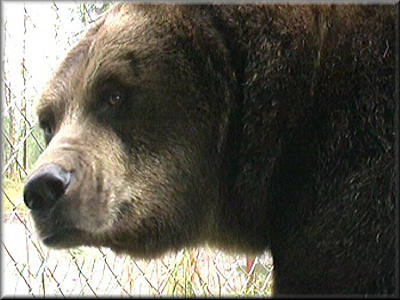
Ursus arctos: Juuso the bear. Photo: The Predator Centre, Kuusamo
In our odd quiet moments we occasionally amuse ourselves by checking out what’s happening in the bear village of Kuusamo, in the north-east of Finland, by watching ‘bear TV’ (the bears speak Finnish only with the staff, but the link offers plenty of expressive action without words).
The brown bear (Ursus arctos) – feared, respected and even mythical animal of the ancient Finns – can weigh more than 400kg. It can run fast (60km/h) and scare the pants off people in the woods, although it always avoids humans if possible. There are approximately 900–1300 wild bears in Finland. This large, intelligent beast hibernates from October to April. Omnivorous, it eats meat as well as plants and berries – carrots, too, if it can lay its paws on them.
Kuusamon suurpetokeskus (The Predator Centre) in Kuusamo has given home to several bears who have lost their mother when cubs or injured in accidents. The bears regard Sulo Karjalainen, their carer – beartaker? – their dear pal, or even mum.
It is really heart-warming to watch him and Pasi Jäntti socialising with their furry friends, who politely – or occasionally slightly rudely – devour the healthy treats that they are given in exchange for posing in several little home movies on their ‘bear TV’ website. In them, the endearing giants – Juuso, Niisku, Vyöti and others – lick Sulo’s cheek, have a bath, and Juuso tests a specially made bear weighing machine and, getting sleepy, a man-made lair with Sulo, his dear pal.
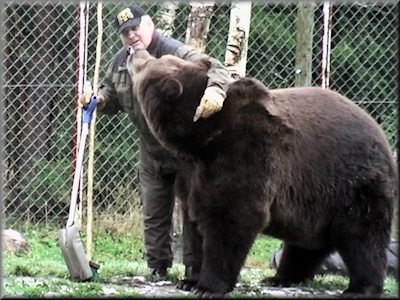
Beartaker at work: Sulo and his 400+-kilo friend. Photo: The Predator Centre, Kuusamo
Dangerous? Texts on the videos point out that only the staff can enter the bears’ home.
Sulo bears a scar on his cheek, yet he is perfectly fearless. With the largest mammal in Europe, there is a risk involved…
Expat, fun
30 August 2013 | In the news
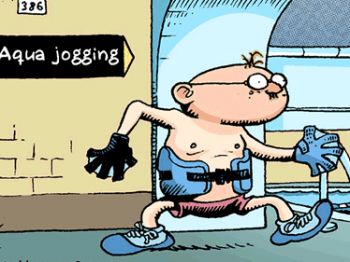
Popular Finnish aqua sports à la Pertti Jarla
Expat Finland, created by Stuart Allt – an Australian web designer living in Turku, Finland – is an information resource on the Internet. It is particularly useful for people moving to Finland, or for anyone who is interested in finding out about Finnish services and products and in living in the country in general.
If you’re looking for maps, restaurants or universities, are interested in knowing more about the language(s), culture, sports etc, take a look at the recently redesigned Expat Finland.
And what do Finns think is funny?
Among latest additions on the Expat site is a selection of comic strips by Pertti Jarla. The creator of the cartoon town Fingerpori is often impossible to translate as he constantly plays with words and their meanings (getting the joke sometimes takes a while, too).
Take also a look at the samples of Jarla’s illustrations to Zoo – eläimellinen tarina (‘Zoo – a bestial story’), a book for children by Roman Schatz and Jarla, featured in Books from Finland.
Where have I gone?
30 June 1988 | Archives online, Fiction, poetry
Poems from Näköisveistos ruumiskirstusta (‘An effigy of a coffin’, 1987). Introduction by Erkka Lehtola
The maple is being stripped for nesting materials
by big crow and his lady.
Their endeavours are more pleasing
than the imminent drinking party, in a finished house
in celebration of early spring. Dreary, to know
in advance that one is insulting one’s guests
– and not even in a constructive manner. More…
Subterranean, pre-verbal
31 March 2007 | Archives online, Essays, On writing and not writing
Claes Andersson, poet and psychiatrist, ponders the difficulties of writing, and how to get down to it. These are extracts from the collection of articles, Luova mieli. Kirjoittamisen vimma ja vastus (‘The creative mind. The rage and burden of writing’, Kirjapaja, 2002)
Some subjects or ideas need years on the back burner before they submit to being written about. The wise writer learns the basic rule ofthe good midwife: don’t panic, don’t force, wait, and help when the time for birth is at hand, but know also when a Caesarean section is advisable or even necessary. More…
Homo ludens, vita brevis
18 March 2011 | Letter from the Editors
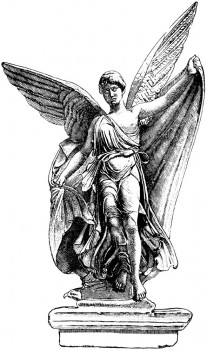
Goddess of victory: charioteer and runner Nike (constructed from the damaged statue of Nike of Paionios, from ca. 420 BCE). Photo: Wikimedia
No one should ever start a piece with ‘already the ancient Greeks…’ , but here goes:
Already the ancient Greeks practised the noble arts of sport. The Romans extended the cultivation (their word!) of culture to leisure, amusing themselves by throwing Christians to the lions. Formula F1 came a couple of thousand years later, as did post-modern art, sitcoms and reality TV, whose presenters take the place of lions and whose celebrities are today’s Christians.
The Olympics, founded by the Greeks, were in full swing as early as the seventh century BCE, until the Christian Roman Caesar Theodocius I banned them as irretrievably pagan in the year 393. However, they were revived 1,500 years later. More…


